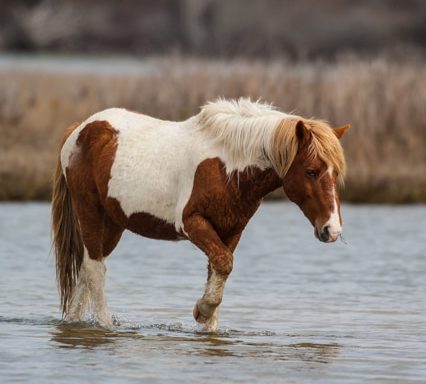Ponies are small equines generally standing less than 14.2 hands high. The word pony can also refer to horses larger than 14.2 (eg. polo pony and German Riding Pony); on the other hand, many smaller horse breeds, such as the Fjord Horse, may mature well under 14.2 hands but are still considered horses by breed rather than stature.
Ponies are not to be confused with miniature horses (which are bred to resemble small horses) even though they may be taller than minis. There are miniature pony breeds, however, such as the dwarf Shetland and Fallabella.
History
It is believed that domesticated ponies were developed from small, hardy wild horses that populated Northern Europe and Eurasia. Their small size was a result of rough living conditions and often scarce grazing, but that also contributed to their tough, hardy, easy-keeping constitutions. Ponies were bred for farm work, driving and transportation, including as pit ponies in the mines hauling heavy loads of coal. They later became purpose-bred for recreational and competitive riding that includes jumping and driving, often with an influx of Arabian blood for refinement.
Characteristics
Ponies often have thicker manes and tails than horses, as well as thicker coats, especially in winter. They have shorter legs, strong hooves, heavier-set bodies, and a short head, large eyes and small ears. Depending on the specific breed the overall body type can range from fine and elegant to stocky and strong.
With their friendly personalities, ponies make wonderful companions and mounts for children, although many pony owners will tell you that their intelligence can also make them stubborn or naughty ‒ not to mention talented escape artists!
There are over 200 known pony breeds in the world that are specifically and carefully bred to maintain size, conformation and temperament. The most common pony breeds seen in North America include:
American Shetland/Shetland
Assateague
Chincoteague
Connemara
Dales
Dartmoor
Exmoor
Falabella
Fell Pony
German Riding Pony (Weser-Ems)
Hackney
Icelandic
New Forest
Newfoundland
Pony of the Americas
Quarter Pony
Sable Island
Welsh
Uses
As long as they are properly trained, ponies are suitable for children from beginners to Pony Club and in the show ring in many different disciplines ‒ hunter hack classes, jumping, driving, games, eventing, gymkhanas, and trail riding. Larger ponies can be ridden by small adults, and are becoming quite popular for novice adult riders or those getting back into riding later in life.
A few ponies have been famous and successful in the international arena; Stroller, a 14.1-hand Thoroughbred/Connemara Pony cross ridden by Marion Coakes on the British Equestrian show jumping team won the individual silver medal at the 1968 Summer Olympics. Multiple USDF Horse of the Year, Seldom Seen, another Connemara/Thoroughbred cross, was only 14.2 hands and competed at the highest levels of dressage with American Lendon Gray. And the 14.1-hand eventing pony Theodore O’Connor (TB/Arabian/Shetland bloodlines), ridden by U.S. Olympian Karen O’Connor, won the individual gold medal at the 2007 Pan American Games in Rio.



